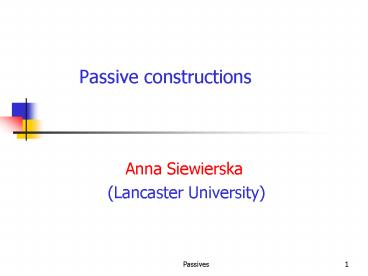Passive constructions PowerPoint PPT Presentation
1 / 24
Title: Passive constructions
1
Passive constructions
- Anna Siewierska
- (Lancaster University)
2
A characterization Siewierska (2005)
- A construction has been classified as passive if
it displays the following characteristics - It contrasts with another construction, the
active - The subject of the active corresponds to an
oblique phrase or is not overtly expressed - The subject of the passive if there is one,
corresponds to the direct object of the active - The construction is pragmatically restricted
relative to the active - The construction displays some special
morphological marking of the verb
3
Swahili
- a. Hamisi a-li-pika chakula
- Hamisi 3sg-past-cook food
- Hamisi cooked the/some food.
- b. Chakula ki-li-pika-wa (na Hamisi)
- food 3sg-past-cook-pass by Hamisi
- The food was cooked by Hamisi.
4
WALS 373 lgs 162 vs. 211
5
Passive prototype Shibatani (1985837)
- An overt agent is not an integral part of
- the passive
- Primary pragmatic function agent defocusing
- Semantic properties
- Semantic valence predicate (agent, patient)
- Subject affected
- Syntactic properties
- Encoding agent ? Ø
- patient ? subject
6
Preference for agentless
- Xiao et al (2004) English get 8.5 English be
10.8 - Sanso (2006) Old Italian reflexive 15.7
Old Italian periphrastic 24.1 - Keresztes (1998) Vogul (27)
- Nikolaeva (1999) Ostyak (43)
7
Passive subjects
- Prototype patient
- Other semantic roles, e.g. recipient,
beneficiary, locative etc. - My sister was given an incredible raise in
salary. - No subject impersonal
8
Icelandic
- a. Stulkan var lamin i
klessu - girlnom was beaten fsgnom in mess
- The girl was badly beaten.
- b. Það var lamið stulkuna i
klessu - it was hitneutsgacc girlacc in
mess - The girl was badly beaten.
9
Pragmatic restrictions
- Passives less frequent than actives
- Passives are felicitous only under certain
conditions - Passives vs. Philippine focus structures
10
Cebuano
- a. Mo-palit ang tawo ug libro
- AF-buy Top man a book
- The man will buy a book.
- b. Palit-on (sa tawo) ang libro
- buy-GF the man Top book
- The man will buy the book.
11
Against Ph. Focus as passive
- they exhibit a very high text frequency
- the agent is typically overt and manifests some
properties associated with syntactic arguments as
opposed to adjuncts - they are semantically highly transitive in the
sense of Hopper Thompson (1980) - and the verb does not exhibit special marking, as
it is also marked in the actor focus
construction.
12
Verbal marking
- periphrastic vs. synthetic
- synthetic origin of marker
- Former auxiliary
- Reflexive marker
- Generalized human subject
- no verbal marking?
13
Three domains Givon (1984)
- Topicalization
- Agent defocusing (impersonalization)
- Detransitivization
14
Topicalization
- Not a necessary characteristic
- In some languages passives are similar to
- OVS
- OV-s
15
Agent defocusing
- Active The agent is more topical than the
patient but the patient retains considerable
topicality. - Passive The patient is more topical than the
agent and the agent is extremely non-topical
(suppressed, demoted).
16
Inverse
- The direct voice is used if the agent is more
topical or ontologically salient than the
patient, and the inverse if the patient is more
topical or ontologically salient than the agent.
Traditionally the more salient or topical
participant is called the proximate and the less
salient or topical one the obviative
17
Inverse
- Plains Cree (Wolfart 197325)
- a. sekih-ew napew antim-wa
- scare-dir manprox dog-obv
- The man scares the dog.'
- b. sekih-ik napew-a antim
- scare-inv man-obv dogprox
- The man scares the dog.'
18
Active, Passive, Inverse
- Active The agent is more topical than the
patient but the patient retains considerable
topicality. - Inverse The patient is more topical than the
agent but the agent retains considerable
topicality. - Passive The patient is more topical than the
agent and the agent is extremely non-topical
(suppressed, demoted).
19
Active impersonal
- Portuguese
- Corta- se cabelos às terças
- Cutpres3sg refl3sg hairpl on Tuesdays
- One cuts hair on Tuesdays.'
- Polish
- W szkole Piotrowi czesto dokucza-no
- in school Peterdat often make funimper
- At school, Peter was often made fun of.
20
Detransitivizing
- Anticausatives
- a. The wind broke the branch.
- b. The branch broke.
- Spontaneous (uncontrolled)
- Polish
- Odbilo mi sie
- hitneut3sg Idat refl
- I hiccupped.
21
Voice
- Narrow view of voice
- Active vs. passive vs. middle (reflexive/reciproca
l) vs. inverse - Broad view of voice (Leningrad School
(diathesis, Kulikov 2007 Croft 2001 Langacker
2004 Shibatani 2006) - Voice is primarily concerned with the way event
participants are involved in actions, and with
the communicative value, or discourse relevance
pertaining to the event participants for the
nature of this involvement (Shibatani 2006219) 1
multiparticipant events
22
Voice Shibatani 2006
- Origin Development Termination
- Spontaneous Middle Benefactive
- Passive Antipassive Applicative
- Causative External Possessor
- Inverse
- Desiderative Resultative
- Potential
23
Parameters of variation
- Synchronic
- The agent
- The subject
- Verbal morphology
- Diachronic
- Origin of verbal marking
- Origin of agent marking
- Degree of grammaticalization
24
The grammaticalization clines
- Phonological change
- P Attrition reduction gt erosion gt loss
- S Fusion Free gt clitic gt affix gt zero
- Morpho-syntactic change
- P. obligatorification gt fossilization gt
morphological loss - S. rigidification word order
- Semantic functional change
- P. extension of semantic range gt loss of
function - S. idiomaticization compositional analyzable
gt noncompositional analyzable gt unanalyzable

